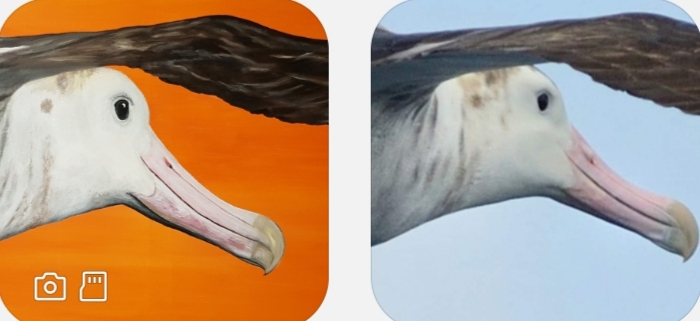
Amsterdam Albatross at sea: a southern Indian Ocean specialty. Artwork by Birgit Bührlé and photograph by Kirk Zufelt
Adrien Chaigne (Centre d’Etudes Biologiques de Chizé, Villiers en Bois, France) and colleagues have published a technical report that analyses four decades (1978-2020) of at-sea surveys of 71 species of seabirds in the Southern Indian Ocean.
The report’s executive summary follows:
“Seabirds are conspicuous and important marine predators. They mostly forage on a diversity of zooplankton (copepods, euphausiids, amphipods) and nekton (squid and fish) prey. Because of their position in the trophic web, high energy requirements, mobility and longevity, these top marine predators can be used as indicators of the spatial variability of marine ecosystem functions and dynamics. We present here distribution maps of resident and migratory seabirds observed in two regions of the Southern Indian Ocean.
The present Atlas focuses on seabird's distribution in the Southern Indian Ocean using a unique long-term dataset (1978-2020) of at-sea observations made repeatedly over two time periods separated by 10 years to examine spatial and seasonal variation in seabird abundance and occurrence at a large spatial scale. Cruises encompassed a 30° latitudinal gradient through tropical, subtropical, subantarctic and Antarctic waters of the Southern Indian Ocean, allowing to explore the distribution of 71 seabird species (or pooled species). This is the first comprehensive summary of information on how some species or communities of seabirds of the Southern Indian Ocean use the habitats of this immense area. The present Atlas aims (1) to summarize the information on the occurrence and abundance of subantarctic and Antarctic seabirds over the period 1978-2020, according to season (austral summer versus austral winter) in two distinct geographical areas in the Southern Indian Ocean (western and eastern areas), and (2) to quantify the species diversity using diverse metrics.
The produced maps provide insights on biogeographic affinities, habitat associations, and "hotspots" of biodiversity and potential predator-prey dynamics. Identifying hotspots is potentially valuable in the design of offshore marine protected area networks. Within the study regions, we found apparent hotspots in subantarctic and Antarctic waters, especially in the vicinity of subantarctic islands. We observed strong seasonal changes in the distribution and abundance of seabirds, which alters the relative importance of these hotspots. The value of hotspots for the protection of these far-ranging pelagic species deserves further study.”
With thanks to Karine Delord.
Reference:
Chaigne, A., Delord, K., Mansoux, B., Bost, C.-A., Weimerskirch, H. & Barbraud, C. 2024. Seabird Distribution in the Southern Indian Ocean: Four Decades of at sea Surveys. CEBC-CNRS Marine Top Predators Team. 203 pp.
13 November 2024

 English
English  Français
Français  Español
Español